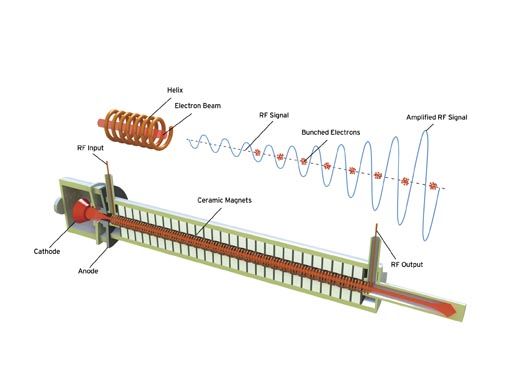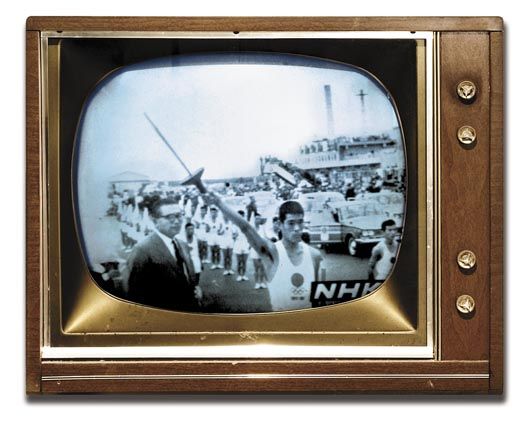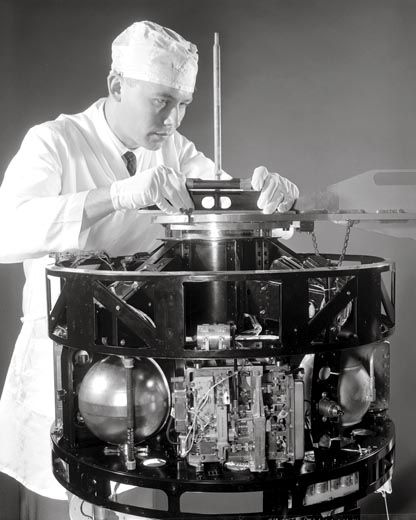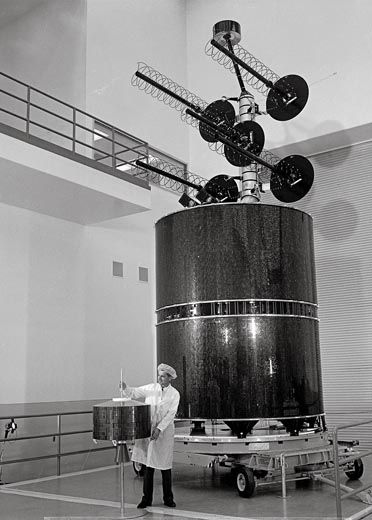Spin Doctors
For that satellite dish on your roof and the phone calls you make to Japan, you can thank Harold Rosen.
/https://tf-cmsv2-smithsonianmag-media.s3.amazonaws.com/filer/Arch_Syncom_Flash_SEP09.jpg)
Modern satellite communications, which today bring us everything from multi-channel television to the Global Positioning System and the nightly weather map, began as a salvage job to restore the prestige of Hughes Aircraft Company’s beleaguered Radar Department.
It was late 1958, and the Los Angeles-area lab was developing a powerful, aircraft-mounted radar for U.S. jet interceptors to target incoming Soviet bombers. Then the Soviets turned to ballistic missiles. Department head Frank Carver went to see Harold Rosen, his young hotshot electrical engineer, who had been trained at the California Institute of Technology. The interceptor is now obsolete, Carver told Rosen, and the radar project is dead. Find something else to do.
The bureaucratic survival instinct does not usually inspire genius, but these were unusual times. The Soviet Union had launched Sputnik the year before and was building bigger and better rockets almost monthly. The United States was racing to catch up.
“Space was on everybody’s mind. You wanted to be part of it, and here was an opportunity,” Rosen says. His tree-shaded ranch house in Santa Monica, the den tastefully furnished with testimonials of his accomplishments, is the same one he bought when he came to Hughes in 1956. Still spry at 83, Rosen consults part-time for Boeing, which took over Hughes’ satellite operations in 2000. He puts in two days a week on such jobs as designing the architecture of communications satellites and helping investigate problems with ones already in orbit.
For years researchers had been talking about the ability to transmit radio signals around the world by using Earth-orbiting satellites as a relay, but in the 1950s, it was still only a dream. There were several ways to make it happen. By 1958, the leading idea was to put a fleet of satellites in Earth orbit at an altitude between 200 and 1,200 miles. A ground station would link to one satellite as it came up over the horizon, then switch to another when the first one was gone. (Even the first active commercial communications satellite, Telstar, which was launched into an elliptical orbit in 1962, was supposed to have been part of a fleet.) A second way was to boost a satellite 22,000 miles above the equator, where it would be in geosynchronous orbit, moving at a speed that constantly kept it over the same spot on Earth. Whoever could put three of these in orbit equidistant from one another could receive, relay, and transmit signals to and from almost anywhere on the planet.
In a 1945 issue of Wireless World magazine, British scientist and science fiction writer Arthur C. Clarke had first outlined for a popular audience how such a system might work. While he wrote of a three-satellite network operating in geosynchronous orbit, he also described an orbiting space station manned by astronauts whose chief job was to change burned-out vacuum tubes. The arrival of the Space Age made Clarke’s orbital concept seem achievable.
Rosen hadn’t thought much about communications satellites, and didn’t know anything about Clarke’s vision, but in early 1959 he started talking to colleagues. Tom Hudspeth, an electronics engineer at Hughes and a ham radio operator, lamented the sorry state of international communications. To use transatlantic telephone service, you had to get in line. And there was no bandwidth for television, he complained. A communications satellite would change everything.
Rosen also sought out Don Williams, a brilliant, Harvard-educated, 28-year-old mathematician and inventor who had worked at Hughes before joining a startup company that built machines to detect dead cockroaches, cigarette butts, and other foreign objects in recycled-glass bottles. Business was good, but Rosen needed him, so he persuaded Hughes to pay Williams an annual salary of $22,000—very high at the time—and got him back. Williams was interested in navigation satellites; Rosen was not. But Williams wanted to put his satellite in geosynchronous orbit, and Rosen was very interested in that.
Then another colleague showed Rosen a journal paper written by two renowned Bell Laboratories engineers—Rudolf Kompfner and John Pierce—that described how to use space for transoceanic communications. The authors and Bell Labs were interested in low-altitude satellites. Rosen saw that low altitude had its virtues; from there, randomly spaced satellites could use omnidirectional antennas to receive and transmit signals. But he also found the approach sloppy, like surrounding Earth with a halo of whirling bowling balls. A geosynchronous system, by contrast, requiring only three satellites, was conservative and neat—“far more appealing to me,” he says now.
There were major challenges: how to transmit the signals; how to keep the satellite from wobbling or drifting out of orbit; whether the United States had enough rocket to lift a payload to 22,000 miles. But Rosen decided to go forward, and during the next four years, he, Hudspeth, and Williams built the world’s first high-altitude communications satellite. The Syncom program was the prototype for an industry that today has 275 satellites in geosynchronous orbit.
The team set to work at Hughes’ Lincoln Avenue campus in Culver City, a few miles from Los Angeles International Airport. They designed the system during normal work hours. No extra money was needed just yet. To get a payload into geosynchronous orbit, the rockets of 1959 would need two extra stages: one to lift the satellite from low altitude up to 22,000 miles, and another to make the resulting elliptical orbit circular. The rocketry was tricky, but Rosen, who had earlier worked on guided missiles at Raytheon, believed it could be done as long as the weight of the spacecraft was kept to a minimum.
The satellite would use a “traveling-wave tube” to amplify incoming radio waves for retransmission (see “How to Pump a Signal,” opposite). Developed by Kompfner and subsequently refined at Bell Labs by Kompfner and Pierce, the tube used a cathode to fire a beam of electrons through a coiled wire surrounded by a magnetic field. Incoming radio signals were transmitted through the coil and, as they interacted with the electrons, were amplified before being beamed back to Earth. Even in today’s satellite communications, traveling-wave tubes are a mainstay.
Hughes’ expert in traveling-wave tubes was John Mendel, a transplant from Bell Labs. He had developed a way to shrink the size of the tube’s magnets, thereby making the device a better fit for aircraft, and especially for spacecraft, where every ounce counted. Rosen told Mendel he needed a traveling-wave tube that was no more than a foot long and weighed no more than a pound. Mendel delivered it.
The most challenging task was to build the attitude- and orbit-control system. Satellites tend to drift away from a desired orbit and need small thrusters for station-keeping. To work properly, a geosynchronous satellite needed to be stabilized in orbit so the communications beam they shined on Earth would be consistent.
The most effective way to stabilize spacecraft in 1959 was with large, spinning reaction wheels, but they weighed a lot and tended to wear out. Rosen, however, had an inspiration. He remembered from his days at graduate school that rotational forces could exert a powerful stabilizing effect on a projectile, such as a bullet or a football. If a satellite were spinning on an axis parallel to Earth’s, station-keeping could be handled by a single thruster. First, however, the satellite, traveling like a tight spiral during launch, would have to be tipped over once it got into orbit so the spin axis would be parallel to Earth’s. Rosen figured he would need four additional thrusters on the satellite to accomplish this. He showed the idea to Williams.
“The basic concept was mine,” Rosen says. “But I didn’t do the math.” Williams did. He showed that by using fast-acting pneumatic valves and short bursts of compressed nitrogen, the satellite could be maneuvered into position with only one thruster. This made construction vastly simpler. Then Williams designed a sensor that could determine the angle between the satellite’s spin axis and the sun. By combining this measurement with information from the satellite’s signal, controllers could determine the spacecraft’s spin axis attitude. Carefully timed pulses from the thruster would then keep the satellite flying in the correct attitude. (This technology would lead to one of the longest patent lawsuits in U.S. history—the “Williams case”—which Hughes filed against the U.S. government in 1973. Hughes claimed the government had used the company’s patented technology on a number of space programs, including the Department of Defense’s Global Positioning System and NASA’s Galileo probe to Jupiter. The government argued that Hughes had exaggerated the importance of the technology and should not have been granted a patent in the first place. In 1999, a federal judge agreed with Hughes, ordering the government to pay $154 million for patent infringement.)
By the end of 1959, the team had a working design. Rosen and Williams presented it to Hughes general manager Lawrence “Pat” Hyland. In an interview with author Helen Gavaghan for her 1998 book Something New Under the Sun: Satellites and the Beginning of the Space Age, Hyland, who died in 1992, described listening to two young engineers with a costly, “hare-brained scheme.” While it sounded plausible, Hyland didn’t want to take the risk. Rosen wanted to launch from a Pacific island on the equator, and Hyland objected: The island was owned by the British, he said, and there was no launch infrastructure. It couldn’t be done. And that was the verdict, at least at first. Management urged the team to seek funding partners, especially the government. Rosen and his team presented their plan to GTE, Bell Labs, the U.S. Army Signal Corps, and the new space agency, NASA. There were no takers.
From the beginning, Rosen said he believed the design offered no technical showstoppers, but others weren’t so sure. Mendel, now retired in northern California, recalls that in 1960 a geosynchronous satellite “was anything but a slam dunk.” The reason: money. “The whole key to this experiment was economics,” he says. “It costs $30 million or $40 million for the launch vehicle, and you have to get the satellite on station and leave it there for years. If you can’t do that, there’s no way to do this and make money.” Rosen’s bluntness and lack of interest in a gradual development plan were not helping matters. “He wanted to go for the whole thing,” Mendel says. “He made some people upset, especially in the government.”
But Rosen’s team had faith in him, and Rosen in them. Hudspeth, Mendel recalls, was “a great nuts-and-bolts guy,” and Williams “was a genius. Nobody else in the country knew how to do what he was doing.” At one point in 1960, the team members decided to kick in $10,000 apiece of their own money and start their own business.
Rosen took the plan to his old bosses at Raytheon, who were interested. But Raytheon wanted to build the satellite without partners, and insisted that Rosen’s team quit Hughes and move to Massachusetts. The Californians weren’t anxious to relocate and Hyland didn’t want to lose them. Williams told Hyland about the team’s self-financing plan and plunked down a $10,000 check to show he was serious. At that point, Hyland finally agreed to fund a prototype.
This working model, completed in 1960 and covered with a gleaming mosaic of dark blue solar cells, is now in a glass case in Boeing’s satellite factory, next to Los Angeles International Airport. It looks like a large snare drum and weighs 55 pounds. By comparison, Boeing’s biggest geosynchronous satellites today weigh more than four tons and stand more than 20 feet tall.
But even with a prototype in hand and systems already tested, Hughes still wanted a partner, and Rosen couldn’t find one. What he and the company did not know was that the Army had its own geosynchronous satellite program, ADVENT. The project was in deep trouble, bogged down by cost overruns and unreasonable scientific requirements. NASA, meanwhile, had an agreement with the defense department stating that it would build only “passive” communications satellites, leaving the “active” programs to the Pentagon. Rosen thought talking to NASA was a waste of time.
In early 1961, Hughes’ management invited John Rubel, the defense department’s assistant director for defense research and engineering, for a visit. Rubel, a former Hughes executive, was in charge of ADVENT and recognized it as a near-hopeless, bureaucratic morass. Now retired in Santa Fe, New Mexico, Rubel recalls that before traveling to L.A. to visit the company, he had heard something about Rosen’s satellite project, but wasn’t expecting to discuss it, since the visit schedule Hughes had given him mentioned nothing about satellite communications. Rosen says he was supposed to brief Rubel on laser programs and was specifically told not to talk about satellites. But he disobeyed orders; “satellites were all we talked about,” says Rosen. He, Hudspeth, and Williams even showed Rubel the prototype and let him pick it up. ADVENT, by contrast, weighed almost as much as two Volkswagens.
That spring, Hughes sent Rosen and his team to show off the satellite at the Paris Air Show. At a showing at the Eiffel Tower, one spectator is reported to have scoffed that that was “as high as it would ever get.”
But things had changed at home. As soon as Rubel returned to Washington, he met with NASA and struck a deal effectively ending the passive/active firewall. If NASA would pay for Hughes to build the satellite, the defense department would supply the ground stations from ADVENT hardware. In August, NASA awarded Hughes a $4 million contract for three geosynchronous satellites. The program would be called Syncom.
“We were thrilled,” Rosen says. Later, Hyland went to brief Howard Hughes, the company’s reclusive founder, and found him sitting in bed surrounded by models of the satellite. Hyland was the only employee who spoke with Hughes. Neither Rosen nor Williams ever met him. Hudspeth’s only encounter was brief and unpleasant: “Tom was walking across Hughes’ landing strip one day,” Rosen says, “and Hughes yelled at him: ‘Stay off the grass!’ ”
On February 14, 1963, the moment of truth arrived. At 78 pounds, Syncom 1 was bigger than the prototype, and rode atop a new Delta rocket. The spacecraft launched flawlessly from Cape Canaveral, Florida, and climbed easily to transfer orbit, where it entered geosynchronous altitude. Then the apogee kick motor ignited for a 22-second burn to circularize the orbit.
One second before burnout, all communication stopped.
“We were devastated,” says Rosen, who is convinced the apogee motor must have exploded. The team made several modifications, and on July 26 they tried again with Syncom 2. Rosen and the other team members waited in a bunker near the launch pad. Again the launch was flawless. Five and a half hours later, the apogee motor lit. Seconds ticked away. The signals continued without interruption, and the room erupted in cheers. We have a mission, Rosen thought. The Delta didn’t have enough power to put the satellite into a strictly geosynchronous orbit over the equator, but with a few ground stations Syncom 2 would work well enough. In August, with the U.S. warship Kingsport acting as a relay in the harbor of Lagos, Nigeria, President John F. Kennedy called Nigerian Prime Minister Abubaker Balewa from the White House for the first satellite conversation between two heads of state.
Syncom 3, launched a year later, attained true geosynchronous orbit over the equator in time to broadcast live the opening ceremonies of the 1964 Summer Olympics in Tokyo, the first continuous TV broadcast across the Pacific. Syncoms 2 and 3 operated until 1966, providing phone service home for U.S. troops in Vietnam.
Hudspeth, who went on to become Hughes’ chief scientist and, like Rosen, a Caltech Distinguished Alumnus, died last year at 89. Williams, perhaps the team’s most innovative thinker, committed suicide in 1966 at age 35.
Rosen is a member of the Inventors Hall of Fame and winner of numerous awards for achievement in engineering. He has a movie-sized, high-definition TV in his den and a satellite dish on his roof. Rosen follows the fortunes of the UCLA and University of Southern California football teams on TV, and loves the Turner Classic Movies channel because, he says, “I can watch movies from my childhood.” He points out that while the antenna used during the Tokyo Olympics cost millions of dollars and provided just a single channel, the 24-inch dish on his roof cost less than $100 and provides 300.
Guy Gugliotta is a writer in Pelham, New York.



